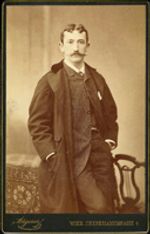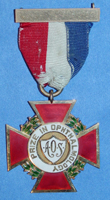 Dr. Carl Koller (1857-1944) was a medical student in Vienna when he befriended a young Sigmund Freud (1856-1939). Experimenting on themselves, Koller and Freud studied a new wonder drug named cocaine. Both felt the effects of cocaine to be extremely beneficial – while Freud felt the drug would be an ideal cure for morphine addiction, Koller noted its numbing effects.
Dr. Carl Koller (1857-1944) was a medical student in Vienna when he befriended a young Sigmund Freud (1856-1939). Experimenting on themselves, Koller and Freud studied a new wonder drug named cocaine. Both felt the effects of cocaine to be extremely beneficial – while Freud felt the drug would be an ideal cure for morphine addiction, Koller noted its numbing effects.
On September 18, 1884 Dr. Koller published a paper describing cocaine as the first local anesthetic. The paper was immediately lauded by ophthalmologists as news spread around the world. Many historians have speculated that Freud was unhappy to have his discoveries concerning cocaine over-shadowed by Koller’s article, but subsequent letters between the two men show their relationship was undamaged. In one of these letters Freud even nicknamed his friend “Coca Koller” (although a homonym, the name was likely not a play on words with the newly marketed American soft drink, Coca Cola, first introduced in 1886).
Despite Dr. Koller’s new found fame, he found himself facing an uncertain future. Dr. Koller felt that he would not be allowed to study ophthalmology in Vienna due to antisemitism – a feeling that was born out in January 1885 when an antisemitic remark at the hospital led to a duel between himself and another medical student. Newspaper accounts at the time and a letter from Freud to his fiancé Martha Bernays all recount the swordfight. Dr. Koller won by wounding his opponent, but surely lost the argument as his prospects in Vienna extinguished altogether.
 In the early fall of 1885 Dr. Herman Knapp (1932-1911) met Koller at a conference held in Heidelberg. In a letter to a colleague, he wrote, “I saw young Dr. Koller, he intends to become an oculist, but is not yet educated in this specialty. He will probably go to Snellen in Utrecht, for being a Jew, as he told me, he had very little chance in Vienna…[I made a toast] on the rising generation of oculists, in particular Dr. Koller who had made us the greatest gift we had received for many years.”
In the early fall of 1885 Dr. Herman Knapp (1932-1911) met Koller at a conference held in Heidelberg. In a letter to a colleague, he wrote, “I saw young Dr. Koller, he intends to become an oculist, but is not yet educated in this specialty. He will probably go to Snellen in Utrecht, for being a Jew, as he told me, he had very little chance in Vienna…[I made a toast] on the rising generation of oculists, in particular Dr. Koller who had made us the greatest gift we had received for many years.”
As Dr. Knapp reported, Dr. Koller did indeed leave Vienna to study ophthalmology in the Netherlands under Herman Snellen (1834-1908). Koller then moved to the United States in 1888. There he was eventually made Chief of the ophthalmology department at Mount Sinai Hospital in New York City.
Over his lifetime, Dr. Koller was the recipient of many awards. Most notably he was the first to receive the Lucien Howe Medal, awarded by the American Ophthalmological Society in 1922. Dr. Koller was also honored with the Adolf Kussmaul Award Medal in 1902 and the New York Academy of Medicine Award Medal in 1930.